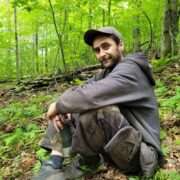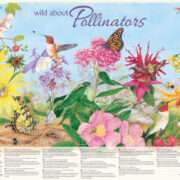He has worked for the Massawippi Conservation Trust since 2018. Previously, he worked with fellow trail builders, Matthew and Mahicans, on another project. He was happy when he was called to join them on the shores of Lake Massawippi. His specialty is building bridges and wood work. He enjoys working in the forest, in the middle of nature. When asked, he said, “ …building the trails makes me happy. It responds to my values.’ He appreciates that the Massawippi Conservation Trust gives the team the time to do a good job. He jokingly said, “There is no competition in the region, we are the best! We can take the necessary time and have the right equipment to make the best trails.” He describes it as a job for people with a passion, it can be a slow job but exciting when the vision for the trail comes to fruition. This is his 7th season working in the milieu.
He appreciates the biodiversity, seeing animals while he works, from foxes to owls and woodpeckers. He has only seen moose tracks and bear scat but has never encountered them in person. He appreciates the fact that the large tracts of land allow these animals to migrate. Working on the conserved land, building trails, he and the team are sensitive to the fragility of the ecosystem.
Trail building involves many skills such as carpentry, handling light machinery, physical strength and creativity to imagine and react to the environment. It also helps to have knowledge of plants and ecosystems, especially when building on our conserved property. The Trust seeks trail builders who will be sensitive to flora and fauna, ensuring that any potential damage to the protected environment is limited. The fact that most of the work is done by hand allows the team to “go gently on the land.”
Building bridges and trails is not his only talent. Dany loves music and culture. In fact, he was our DJ at Ethan’s Beach opening last summer. He brought his equipment and played a wide variety of early jazz and blues. He has participated in many cultural events over the years. He has also worked in construction and in the agricultural sector. He is a natural communicator and enjoys working with the community, bringing together like-minded people.
Dany is an important member of the team and we are happy to have him on board to build bridges and more!




